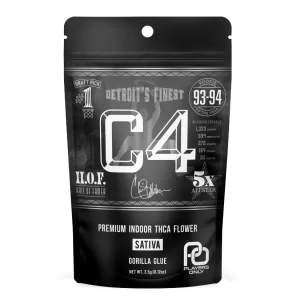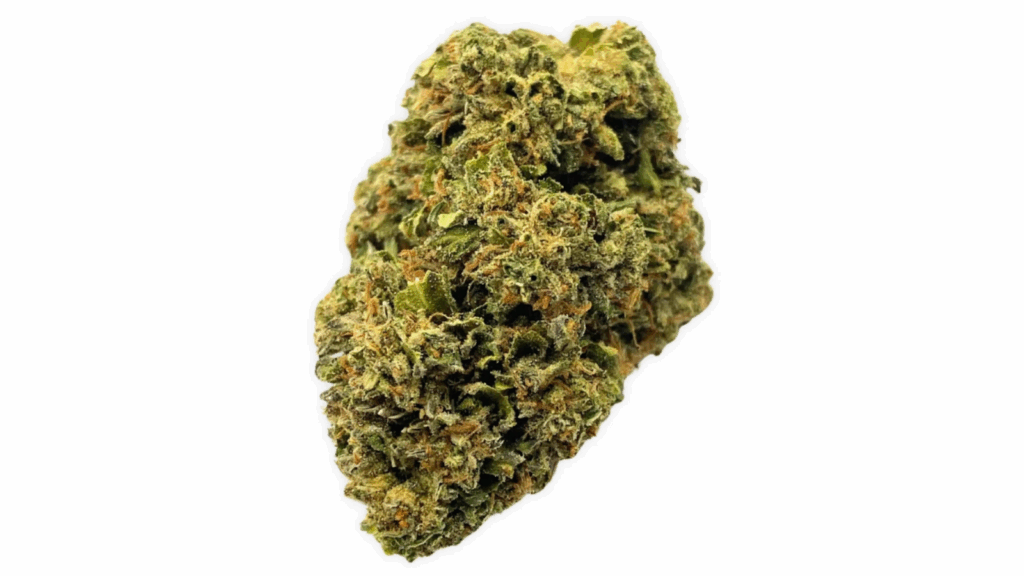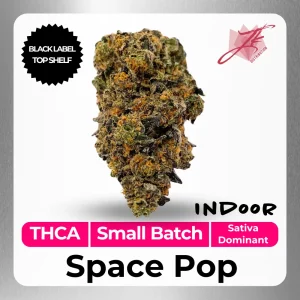Sativa THCA Flower
Long days, early starts, and to-do lists that never quit, and sometimes you need a product that meets you where you are. That’s where our Sativa THCA Flower comes in. At JK Distro, we’ve partnered with trusted growers and researchers to bring you a vibrant collection of hemp-derived THCA flower sourced from premium cannabis hemp. Every strain is backed by third-party lab testing, detailed terpene breakdowns, and a commitment to transparency you can trust.
As a team rooted in cannabinoid education, we’re here to walk you through what Sativa THCA Flower is, how it interacts with your body’s endocannabinoid system, and how it may fit into your daily rhythm—whether that’s a brainstorming session, a creative stretch, or a midday reset. Let’s explore the science, the benefits, and the best ways to make this product your own.
-
 Rated 0 out of 5Sale!Add to cart Custom Button
Rated 0 out of 5Sale!Add to cart Custom Button$39.99Original price was: $39.99.$12.99Current price is: $12.99.
How Sativa THCA Flower Interacts With Your Body
Sativa THCA Flower stands out not only for its vibrant terpene profile, but also for how it works with your body once consumed. Whether you’re sparking up a session before a creative sprint or adding it to a dry herb vaporizer after a long commute, the experience starts with a unique transformation process called decarboxylation. Let’s break it down.
How Decarboxylation Activates THCA
When you apply heat to hemp-derived THCA through smoking, vaping, or baking, it undergoes a chemical shift known as decarboxylation. This process converts THCA into hemp-derived Delta 9 THC, a cannabinoid that interacts more directly with receptors in the endocannabinoid system (ECS).
This change is what allows you to experience the activated effects of cannabis hemp flower. For many in our community, using Sativa THCA Flower in a heated application fits into moments where energy, movement, or creative momentum matter. While each body responds differently, this method introduces a more direct experience that may complement active routines or mid-morning resets.
Raw Form, Real Potential: What Happens Without Heat
You don’t need to light up to explore THCA’s potential. In its raw form, such as in freshly harvested buds or cold applications, THCA remains unconverted. This version doesn’t activate the same pathways as hemp-derived Delta 9 THC, but it still interacts with your ECS in distinct ways.
Studies suggest that raw THCA may contribute to your body’s internal balance through its interactions with receptors tied to digestion, immune response, and other regulatory functions. While research is still evolving, there’s growing interest in how raw cannabinoids may fit into functional wellness routines. Some people add raw THCA flower to smoothies, cold-press recipes, or low-temp infusions to explore its unheated potential.
How Sativa Terpenes Shape Your Experience
Sativa strains invite a unique mix of terpenes and minor cannabinoids that may help guide how your session feels. In Sativa THCA Flower, dominant terpenes like limonene, pinene, and terpinolene often appear in higher concentrations. These aromatic compounds interact with hemp-derived THCA to help shape the full-body experience known as the entourage effect.
For daytime hemp sessions or projects that require a little lift, Sativa THCA Flower can be part of a routine that prioritizes stimulation without weighing you down. We often hear from customers who reach for Sativa strains when they’re getting outside, working through a project list, or prepping for creative focus.
When Should You Use Sativa THCA Flower Instead Of Indica?
Not all hemp-derived flower works the same way. The type of strain you reach for can shape how your session fits into your routine. At the heart of this difference is the terpene profile, the cannabinoid balance, and the role your body’s endocannabinoid system plays in how you metabolize it. Let’s walk through what sets Sativa and Indica THCA Flower apart, and when each might be the right match for your day.
Sativa THCA Flower: For Active Days And Recharges
Hemp-derived Sativa THCA Flower often shows up in daytime routines. Its signature terpene makeup, usually rich in limonene, pinene, and terpinolene, may shape how your body responds after decarboxylation. These terpenes are known for their bright, sharp aromas and are commonly linked with activities that call for alertness, movement, or flow.
If you’re prepping for a long day of errands, diving into a creative project, or simply looking to stay engaged with your surroundings, Sativa strains might feel more in sync with those goals. Our community often turns to Sativa THCA Flower for weekend hikes, studio sessions, or midday pick-me-ups that keep them present and productive.
Indica THCA Flower: For Evening Sessions
On the other hand, Indica THCA Flower tends to feature terpenes like myrcene and linalool, which are often connected with heavier aromas and slower rhythms. This kind of flower may feel more aligned with quiet evenings, end-of-day rituals, or moments when you’re looking to dial things back.
Many people reach for Indica flower after dinner or during a wind-down session before bed. It’s the type of experience that pairs well with a favorite show, a long soak, or stretching out on the couch with no plans in sight.
How Terpenes Shape the Feel Of Sativa THCA Flower
Terpenes, aromatic compounds found in cannabis hemp, play a major role in how each strain smells, tastes, and interacts with your body. While they don’t act in isolation, their synergy with hemp-derived THCA can guide how your session unfolds. Let’s explore how terpenes influence strain profiles and what to expect from those most common in Sativa THCA Flower.
Terpenes Help Define The Personality Of A Strain
Every strain has a story, and terpenes are a big part of how that story is told. These compounds shape everything from aroma and taste to how your body responds once cannabinoids are introduced. In hemp-derived Sativa flower, you’ll usually find terpenes that lean zesty, herbal, or crisp—flavor notes often associated with brightness and motion.
The way terpenes interact with hemp-derived THCA, CBD, and other minor cannabinoids is often called the entourage effect. This concept refers to the way plant compounds work together to create a fuller, more layered experience.
Common Sativa Terpenes
The dominant terpenes in Sativa THCA Flower tend to show up in bold, expressive ways. Here are a few to keep on your radar:
- Limonene: Known for its citrus aroma, this terpene is often linked to fruit-forward strains that feel bright and expressive. It’s frequently found in Sativa strains that pair well with outdoor plans or creative blocks.
- Pinene: As the name suggests, this terpene carries a fresh pine scent. It’s often present in strains that pair well with movement.
- Terpinolene: This one’s a bit of a shapeshifter. Its aroma can come across as floral, herbal, or even slightly spicy. It’s a frequent guest in strains that stand out for their unique personality.

How To Properly Store Sativa THCA Flower
Keeping your sativa THCA flower fresh is essential for both potency and enjoyment. If you’ve invested in premium hemp-derived THCA flower, proper storage ensures every session maintains its vibrant aroma, flavor, and cannabinoid profile. Here are a few easy ways to keep your hemp-derived flower in top shape:
- Keep It Cool, Not Cold: Heat can wear down the quality of cannabinoids. Try storing your flower in a dark, temperature-stable space between 60–70°F. While it might be tempting, the fridge or freezer isn’t the best option. Sudden shifts in temperature can cause trichomes to become brittle and flake off.
- Balance the Humidity: Aim for relative humidity between 55–62%. This range helps preserve the texture, aroma, and cannabinoid content of your flower. Airtight glass jars work well when paired with humidity packs.
- Limit Exposure to Light: UV rays can gradually break down the delicate compounds found in hemp-derived flower, including THCA, CBD, and terpenes. To keep your flower shelf-ready, stash it in a cabinet, drawer, or opaque container.
- Seal Out the Air: Once air gets in, cannabinoids begin to oxidize. After opening your jar, seal it again as soon as possible to slow the aging process. For longer-term storage, vacuum-sealed bags can help lock in freshness and reduce exposure.
- Minimize Handling: Every time you open your jar, your flower faces shifts in temperature and humidity. To avoid this, portion out what you need ahead of time and leave the rest sealed until you’re ready to dive back in.
Read more:
Frequently Asked Questions About Sativa THCA Flower
Can I use Sativa THCA flower for anxiety or depression?
While many people are curious about using hemp-derived cannabinoids like Sativa THCA flower for mood support, it’s important to approach this with care. Studies suggest certain cannabinoids, particularly CBD and hemp-derived THCA, may help with everyday stress, mood, or relaxation. However, hemp-derived products are not formulated to treat, cure, or prevent conditions like anxiety or depression. As always, we recommend consulting a trusted health professional when exploring how Sativa THCA flower may fit your wellness routine.
What’s the best way to consume Sativa THCA flower?
Sativa THCA flower is versatile! You can smoke it, vape it with a dry herb vaporizer, or even infuse it in recipes. Keep in mind: heating activates THCA, turning it into hemp-derived Delta 9 THC, which offers a different experience. Many of our community members also blend Sativa THCA flower with CBD-rich blends for a smooth, balanced effect. Choose the method that matches your lifestyle and preferences.
Are there side effects of using Sativa THCA flower?
Most people find Sativa THCA flower to be well-tolerated, though, like all hemp-derived cannabinoids, there are possible side effects. Some users report dry mouth, red eyes, changes in appetite, or mild changes in mood or perception—especially if large amounts are consumed. If you’re new to hemp flower, start slow and see how you feel. Your experience will also depend on your body’s chemistry and tolerance.
How much Sativa THCA flower should I use as a beginner?
We recommend starting with a “low and slow” approach. For most first-time hemp flower users, a single small inhale or a “pinch” (about 0.1-0.2 grams) is a good place to begin. Wait at least 20–30 minutes to gauge the effects. Every person’s endocannabinoid system is unique, and starting slow ensures you can enjoy your experience and adjust as needed.
How long does it take to feel the effects of Sativa THCA flower?
The onset time depends on your consumption method. If you smoke or vape Sativa THCA flower, effects can typically be felt within a few minutes. If you infuse it in edibles (and activate it by heating), the onset may take 30–90 minutes. Everyone’s body is different, so we always suggest waiting before deciding to consume more.
Are there any drug interactions with Sativa THCA flower?
While hemp-derived cannabinoids like THCA are generally safe for most adults, some compounds, especially in larger amounts, may interact with certain medications. If you are using prescription drugs, especially for chronic health conditions, consult your health professional before adding Sativa THCA flower to your routine. Your safety and wellness always come first.
What are the common terpenes found in Sativa THCA flower?
Sativa THCA flower offers a rich bouquet of terpenes, which contribute to its aroma and unique effects. Popular terpenes include limonene (citrusy, uplifting), pinene (fresh pine, focus), and terpinolene (herbal, energetic). These aromatic compounds work alongside cannabinoids, helping shape your experience and the essence of the flower.
How does the entourage effect work with Sativa THCA flower?
The “entourage effect” refers to the way hemp-derived cannabinoids, terpenes, and other plant compounds work together in cannabis hemp. When you use Sativa THCA flower, you experience not just THCA but also minor cannabinoids like CBD and CBG, along with a spectrum of terpenes. Studies suggest this synergy may offer a broader, more balanced range of effects than isolated cannabinoids. It’s about getting the most from the whole plant—something we’re deeply passionate about.



